Sea Anemones: The stinging, fishing-eating, fighting flowers of the sea
Sea Anemones (ah-nem-uh-nees) were named after Anemone flowers, a family of lovely, terrestrial flowers found around much of the world. Looking at colourful Sea Anemones swaying in the ocean current, one can see why they were compared to a garden full of beautiful flowers. However, unlike their namesake, Sea Anemones are in fact fearsome, carnivorous animals! Animals that can move and swim and will use their stinging tentacles to fight each other, stun their prey, and even swallow fish whole. While not all Sea Anemones are fearsome fighters, there are more than you might think and they are not to be messed with.
Sea Anemones are tubular, soft-bodied animals with a flat base that holds them to a surface and a central mouth on top that is surrounded by iconic tentacles. They are found throughout the world’s oceans and are members of the phylum Cnidaria, a group of animals that utilize specialized stinging cells to capture prey, which also includes jellyfish and corals. An anemone’s stinging cells, called nematocysts, are found throughout the body but are primarily used in their tentacles as a hunting tool and defence mechanism. Each tentacle is equipped with thousands of nematocysts that contain a tiny, coiled, harpoon-like structure which is ejected upon contact with prey, piercing their skin and pulling them into their mouth. Luckily, most anemones don’t have large enough stinging cells to affect humans, but there are some to be wary of. If you have ever touched a small anemone, the sticky feeling you may have felt is caused by those tiny harpoons as the anemone tries to eat your finger.

Walking through the intertidal zone you may see a number of anemones that are common here on the coast of BC. We have several species that showcase some of the amazing features of anemones, from symbiotic relationships with algae to reproduction via cloning. A common and easily recognisable anemone is the k’inłimc or Green Surf Anemone (Anthopleura xanthogrammica). This brilliant green anemone loves to grow in high energy areas of the intertidal zone. Crashing waves and surging water give this anemone a lot of opportunities to catch food in its tentacles. Green Surf Anemones will eat anything that they can catch including seaweed, fish, mussels, and crabs. Green Surf Anemones also have an interesting symbiotic relationship with microalgae that live within their tentacles – the algae is protected within the tentacles and in exchange provides some extra nutrients to the anemone, as well as adding to its green colouration. Other anemone species use symbiotic relationships with fish and crabs (some tropical anemones and clownfish being a famous example!) offering protection in exchange for food scraps.

Another common species in our waters is the Giant Plumose Anemone (Metridium farcimen or Metridium giganteum) commonly found growing on rocks, docks, and pilings. They are easily recognized by their white or brown tubular bodies and their white, feathery looking tentacles that help them feed on microscopic plankton floating by. These anemones are some of the tallest in the world, measuring in at over 1 m tall but can quickly pull in their tentacles and deflate into a flattened mushroom-like mass for protection. Plumose anemones reproduce sexually, releasing eggs and sperm into the water to be fertilized. Other species of anemones in the area, such as Pink Tipped Anemones (Anthopleura elegantissima) or Strawberry Anemones (Corynactis californica) reproduce asexually by cloning themselves. They will split in two or bud a new individual off their body leading to large aggregations and colonies of genetically identical individuals. There is even one species called the Beadlet Anemone (Actinia equina) found off the coast of the UK that is viviparous, meaning they give birth to live young (spitting them out of their mouth) after internal fertilization.
But what about those fighting, stinging, fish-eating anemones. Well, we have those here too. Fishing-eating Anemones, or Rose Anemones (Urticina piscivora), are large solitary anemones growing up to 30 cm tall and 30 cm wide that live in the subtidal region. Their tentacles pack a much more powerful sting that can damage human skin and ensnare whole fish. These red and pink coloured anemones prey on fish, shrimps and other invertebrates and will devour them whole, spitting out shells and other waste when they’re finished.

In some species, when individual anemones move too close to each other, someone usually gets upset. This can spark battles as the anemones unleash secondary defence tentacles and engage in some seriously slow and seriously intense fighting. Their thicker, club-like secondary tentacles will emerge from beneath their main tentacles and begin slowly attacking their rival anemone. The flight can be long as they compete for a good spot on the seafloor, and unfortunately, sometimes both anemones lose if they sustain too much damage.
So, it turns out anemones are more than just a bunch of tentacles. What many people think are pretty plants are actually slow moving carnivores with a hunger for fish. They clone themselves, maneuver around rocks, fight for territory, and eat everything from microscopic plankton to unsuspecting crabs and fish. Don’t underestimate these fish-eating flowers of the sea.




